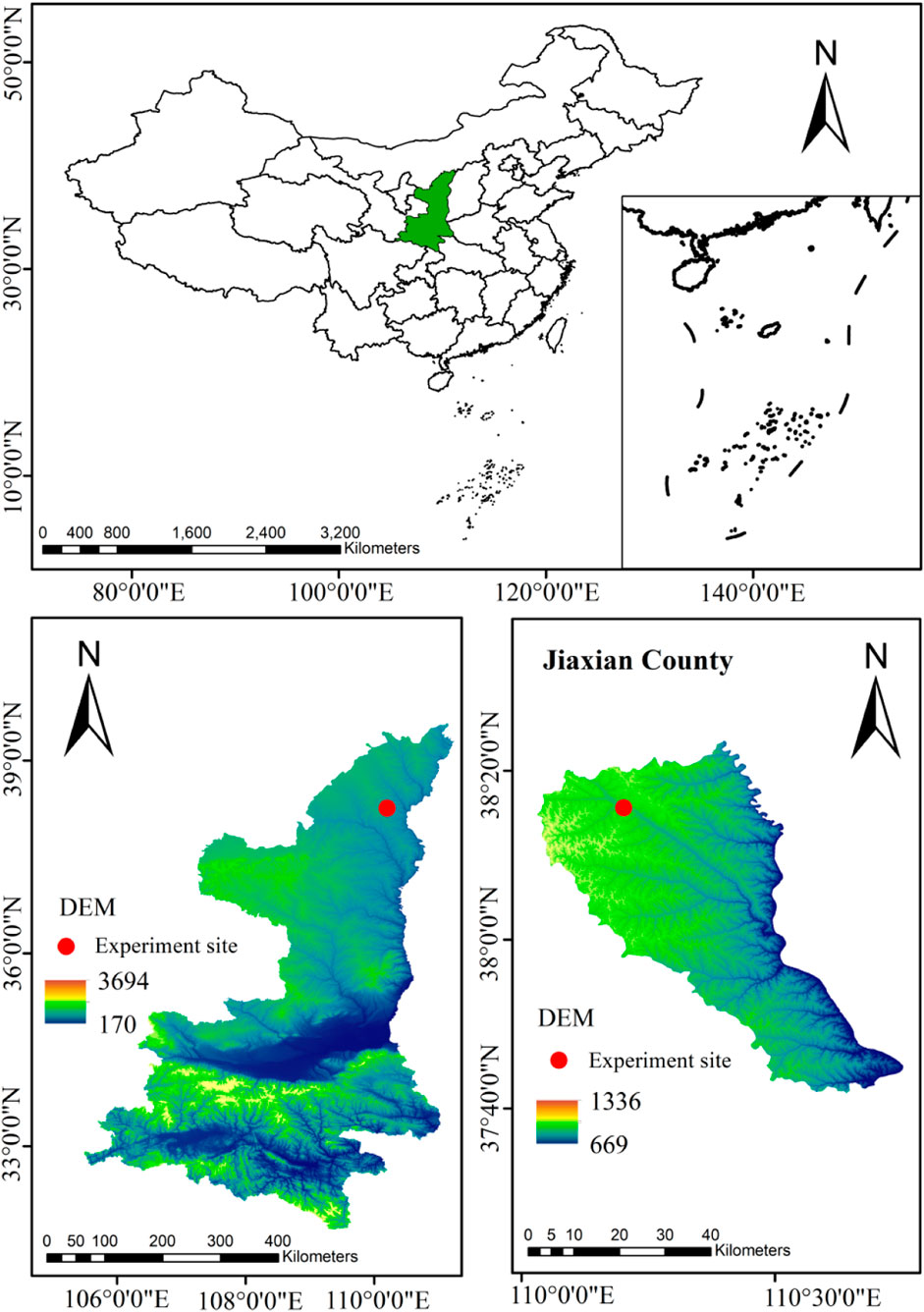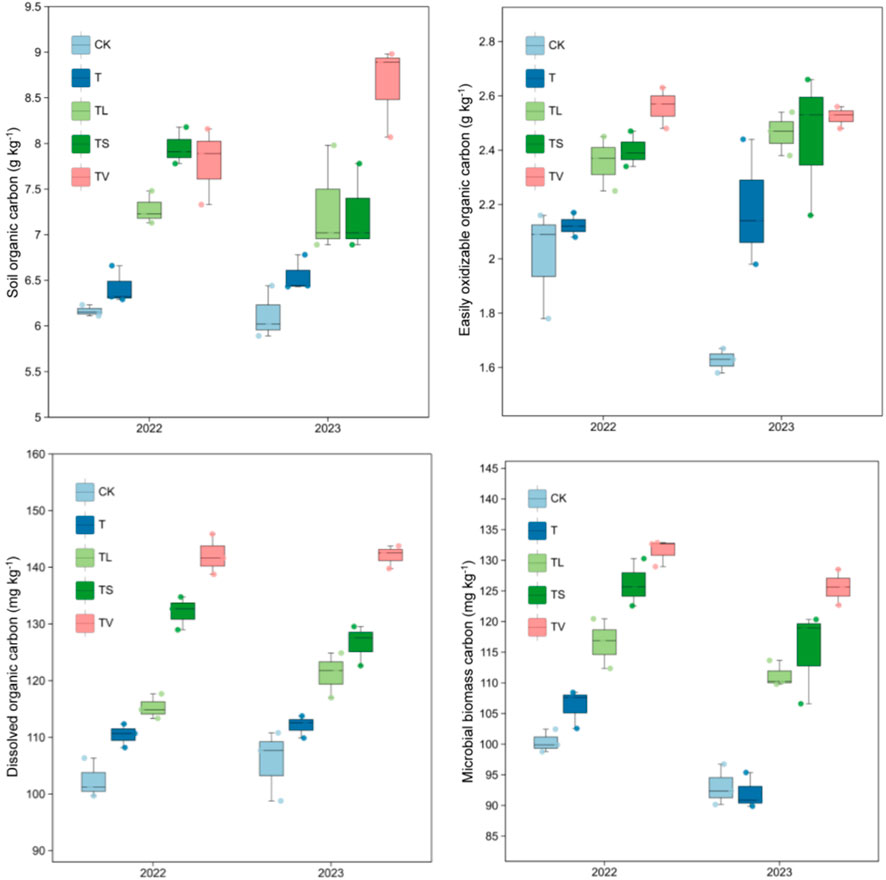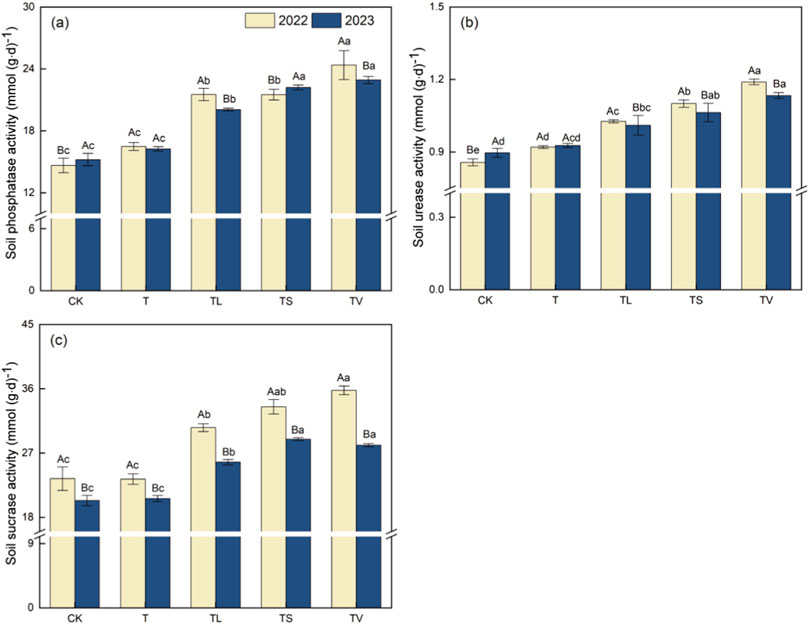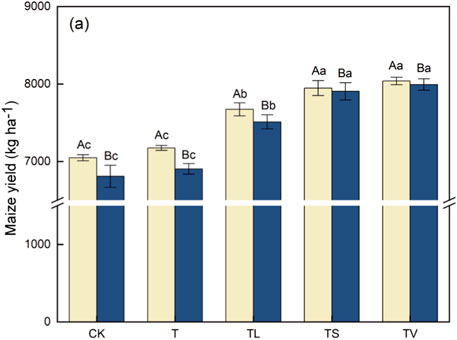- 1Key Laboratory of Applied Ecology of Loess Plateau, Shaanxi Province, Yan’an University, Yan’an, Shaanxi, China
- 2Research and Development Centre of Ecological and Sustainable Application of Microbial Industry of the Loess Plateau in Shaanxi Province, Yan’an University, Yan’an, Shaanxi, China
- 3College of Life Sciences, Yan’an University, Yan’an, Shaanxi, China
- 4State Key Laboratory of Urban and Regional Ecology, Research Center for Eco-Environmental Sciences, Chinese Academy of Sciences, Beijing, China
Arable soil and crop productivity are severely affected by salinization. Therefore, soil amendments are an important measure for improving saline-alkali soil for agricultural development. Desulfurized gypsum is a common soil amendment that has been used repeatedly alongside organic materials to improve the biological, physical, and chemical properties of saline soil. This study takes the typical saline-alkali farmland soil in Yulin as the research object, and five treatments were established: a blank treatment (CK), a single application 2.5 t ha−1 of desulfurized gypsum (T), 2.5 t ha−1 of desulfurized gypsum and 1.5 t ha−1 of green manure (TL), application 2.5 t ha−1 of desulfurized gypsum and 1.5 t ha−1 of straw (TS), and 2.5 t ha−1 of desulfurized gypsum and 1.5 t ha−1 of organic fertilizer (TV). The results show that the TV treatment achieved a significant improvement in soil nutrients, organic carbon, enzyme activity, and maize yield. In 2022 (2023), the compared of organic matter, TN, TP, TK, AP, and AK increased significantly compared with the CK treatment when the TV treatment was applied. Soil phosphatase activity (SPA), soil urease activity (SUA) and soil sucrase activity (SSA) significantly higher in the TV treatment compared with the other treatments and increased significantly over the two-year period. Furthermore, soil organic carbon (SOC), easily oxidizable organic carbon (EOC), dissolved organic carbon (DOC) and microbial biomass carbon (MBC) also significantly increased with the 2022 and 2023 TV treatments. Correlation analysis revealed a positive relationship between maize yield and soil nutrients, organic carbon, and enzyme activity (P < 0.05). Thus, the TV treatment was determined to be the optimal treatment for soil improvement. This conclusion was supported by analyses performed using membership function analysis, gray correlation analysis, and entropy TOPSIS model evaluation. Therefore, this method increases soil quality, improves soil fertility, achieves high maize yields, and provides a scientific basis for enhancing and utilizing saline-alkali soil in the Loess Plateau.
1 Introduction
Soil salinization is an important factor affecting food production and soil environments (Boamah et al., 2021). China experienced a notable decrease in cultivated as a result of extensive farmland reforestation (Qi et al., 2010). The prevalence of soil salinization poses a considerable challenge to local green agriculture productivity and sustainable development, hindering efficient land resource utilization and ecological environment enhancement. Addressing issues related to saline-alkali land is consistent with China’s ecological security policies and is essential for promoting ecological agriculture practices (Ai et al., 2023). Addressing issues related to saline-alkali land is consistent with China’s ecological security policy and is essential for promoting ecological agriculture practices.
The primary purpose of improving saline land is to reduce soil salinity, enhance soil structure, and improve soil fertility (Toubali et al., 2022). This involves reducing saline-alkali barriers and implementing designed to boost soil fertility. Gypsum is extensively utilized as a chemical amendment in the improvement of saline-alkali soil, its addition replacing exchangeable sodium with calcium, Various studies have shown that this approach enhances physical and chemical soil properties. The application of gypsum in sodic soil has been found to positively influence the bulk density, hydraulic conductivity and sodium adsorption of the soil. Additionally, long-term experiments have demonstrated that the combination of rice straw and gypsum in saline-alkali soils can improve soil porosity and average aggregate weight diameter (Lu et al., 2018). Organic materials—including organic fertilizers, straw, and biochar—improve soil structural characteristics and boost soil fertility while simultaneously minimizing environmental harm resulting from the excessive use of chemical fertilizers (Misra et al., 2019). By incorporating external organic materials, the capacity of activated carbon reservoirs can be increased and balance in organic carbon reservoirs can be maintained (Zhou et al., 2022). The use of organic materials can expedite the leaching of exchangeable sodium in saline soil, thereby reducing soil alkalinity and electrical conductivity (Kovacova and Veliskova, 2012).
Soil organic carbon (SOC) is a crucial component of the soil carbon pool and serves as a significant indicator of soil quality (Kohout et al., 2021; Jiang et al., 2021). SOC consists of two primary components: stable organic carbon and active organic carbon. Active organic carbon, which has a rapid turnover rate and is easily decomposed by microorganisms, is considered relatively unstable in the soil (Petersen and Hoyle, 2016). Although it represents a small proportion of the overall soil composition, soil active organic carbon is sensitive to field-management practices such as fertilization and tillage matter (Sun et al., 2021). Enzyme activities serve as benchmarks for assessing soil health, biological activity, and fertility. Monitoring soil enzyme activities is critical to gaining insights into soil ecosystems. It is a valuable tool for determining ecosystem health, evaluating environmental impacts, and guiding sustainable land-management practices.
For many years, the primary focus of experts and scholars has been on reducing soil salinization, enhancing soil fertility, and establishing a suitable soil ecological environment. While research on improving saline soil has produced impressive results, there has been a limited exploration of the combined impact of desulfurized gypsum and organic materials on soil physical and chemical properties. Most studies have instead focused on managing saline-alkali soils in the arid northwestern regions of China, overlooking the potential synergistic fertilization effects on saline-alkali soils in the Loess Plateau (Ma et al., 2018; Bao et al., 2016; Jia et al., 2019). This study addresses this gap by investigating the influence of desulfurized gypsum and organic materials on soil properties in real-world conditions, with the goal of establishing a scientific foundation for refining the carbon-sequestration strategy for saline-alkali soil on the Loess Plateau and utilizing industrial and agricultural by-products to enhance soil quality and fertility.
2 Materials and methods
2.1 Experimental site
The 2- year field experiment conducted in Jiaxian County, Yulin City, Shaanxi Province (38°16′54′′N, 110°10′48′′E) (Figure 1). This area have a warm temperate semi-humid monsoon continental climate with four distinct seasons. The elevation is 1,192.0 m above sea level. The average temperature is 10°C, the annual cumulative temperature is 3,030°C, and the annual average rainfall is 386–404 mm. The top soil (0–20 cm) contains 0.89 g kg−1 of total nitrogen (TN), 0.45 g kg−1 of total phosphorus (TP), 13.45 mg kg−1 of total potassium (TK), 10.98 g kg−1 of organic matter, available phosphorus (AP) of 16.87 mg kg−1, available potassium (AK) of 128.96 mg kg−1, and moisture content of 12.13%, with a pH (soil: H2O = 1:5) of 8.4.
The experiment carried out in 2022 and 2023, using a completely randomized block design, Based on the physical and chemical properties of the soil, the following five soil-improvement treatments were designed: 1) no fertilizer (CK); 2) desulfurized gypsum (T, 2.5 t ha−1); 3) 2.5 t ha−1 desulfurized gypsum and 1.5 t ha−1 green manure (green manure is Astragalus adsurgens Pall).(TL); 4) 2.5 t ha−1 desulfurized gypsum and 1.5 t ha−1 straw (TS); and 5) 2.5 t ha−1 desulfurized gypsum and 1.5 t ha−1 organic fertilizer (TV). The plot is 30 m2 (5 × 6 m). Then, nitrogen fertilizer (urea) at 180 kg ha−1, phosphorus fertilizer at 90 kg ha−1, and potassium fertilizer at 120 kg ha−1 were uniformly applied as base fertilizers and mixed into the 0–20 cm soil layer before planting. During the maize growth period, groundwater was used for irrigation based on local farmers’ habits. Pest, disease, and weed control methods followed local agricultural practices.
2.2 Measurements and methods
Soil samples were collected from the post-corn harvet using a soil drill and quickly brought back to the laboratory. The soil samples were sieved through a 2-mm sieve and stored in a 4°C refrigerator for the analysis of enzyme activity. The remaining soil samples were air-dried and sieved to determine the basic physical and chemical properties of the soil. Maize yield and biomass at maturity were assessed by selecting three 1 m × 1 m plots in the central area of each plot. The samples were then dried at 105°C for 30 min to inhibit biological activity, followed by further drying at 75°C until a constant weight was achieved (grain yield values were adjusted to account for 14% moisture content), and the thousand-grain weight was recorded.
The potassium-dichromate-oxidation external heating method was used to measure organic matter in the soil (Osman et al., 2013). Available phosphorus (AP) was extracted with 0.5 mol L−1 sodium bicarbonate and its content determined through molybdenum antimony anti-colorimetry, whereas available potassium (AK) was extracted with 1 mol L−1 ammonium acetate and its content determined using a flame photometer. Soil samples were 2 g and digested using a mixture of sulfuric acid and perchloric acid at mixed rate of 3:1, The digested was diluted with distilled water to a volume of 100 mL. Then, 5 mL extracted from this digest were analyzed for the content of these nutrients as follows: total nitrogen (TN) was determined by the macro-Kjeldahl method, total phosphorus (TP) was determined by spectrophotometry, and total potassium (TK) was measured using a flame photometer as described in the literature (Zhao et al., 2018).
Soil organic carbon (SOC) was measured using the potassium-dichromate-oxidation external heating method; easily oxidizable organic carbon (EOC) was measured using the potassium-permanganate-oxidation-colorimetric method; dissolved organic carbon (DOC) was measured using the distilled-water extraction method; and microbial biomass carbon (MBC) was determined using the chloroform fumigation method.
Soi phosphatase activity (SPA), soil urease activity (SUA), and soil sucrase activity (SSA) were determined by benzene bisphosphate, sodium phenol hypochlorite, and 3,5-dinitrolic salicylic acid (Dick et al., 1997).
2.3 Comprehensive evaluation
2.3.1 Membership function method
According to the indicators of maize yield, organic matter, total nitrogen, total phosphorus, total potassium, available phosphorus, available potassium, phosphatase, urease, sucrase, soil organic carbon, easily oxidizable organic carbon, dissolved organic carbon and microbial biomass carbon conduct were used to conduct a comprehensive evaluation of the best treatment using membership functions analysis. The subordination function value of each indicator was calculated as follows:
Z is the measured value of the index for a specific treatment, where μ1 represents the forward indicator, and μ2 represents the reverse indicator. zmin and zmax denote the minimum and maximum values of the measured indexes across all of the treatments, respectively. If the measured index is positive, Equation 1 is used to calculate the membership function value; otherwise, Equation 2 is used.
2.3.2 Weighted TOPSIS method
A comprehensive evaluation analysis based on the entropy weight TOPSIS model was conducted for five different treatments. The calculation process and formula are as follows:
According to the screening target, the range change method is used to standardize the indicators, and the standardized matrix A is obtained.
Where xij is the normalized value; xij is the initial value of the i indicator in the j treatment; i = 1, 2, 3, ..., m (m is the number of evaluation indicators, taken as 14 in this study); j = 1, 2, 3, ..., n (n is the number of evaluation processes, taken as 5 in this study). The matrix can be obtained according to the following formula:
The proportion of the i indicator in the j treatment is then calculated.
The indicator information entropy is then calculated as follows.
Then, the indicator difference coefficient gj and indicator weight wj can be calculated.
The weight of each indicator calculated by the entropy weight method is then multiplied by the j column of the matrix A to make the decision matrix R.
The positive ideal solution and negative ideal solution of each indicator can be obtained from matrix R.
The Euclidean distance D between each target value and the ideal point is calculated based on the weighting matrix R+, R− and D−. The Euclidean norm is used to calculate the distance between each treatment and the ideal solution and the closeness Ci of each treatment to the ideal solution.
2.3.3 Gray correlation degree analysis method
The correlation degree is the average of the correlation coefficients under each series, which can be used to compare the advantages and disadvantages of each treatment (Wang et al., 2024)
Where ξi is the correlation coefficient, x0 is the reference value, xi is the comparison value, ρ ∈ [0, 1] is the resolution coefficient, mini mink | x0(k) - xi(k) | is the two-level minimum range, Ei is the two-level maximum range.
2.4 Data analysis
Graphs were plotted with Origin 8.0 and Mathematica 9.0. Multiple comparisons were performed using the Duncan new compound-difference method analysis. Significant differences between the detected parameters were compared using Tukey’s honest significant difference (HSD) test at the 95% confidence level (p < 0.05).
3 Results
3.1 Soil pH and exchange sodium percentage (ESP)
Soil pH and ESP under various amendment treatments were analyzed and are presented in Table 1. In 2022 and 2023, all of the improvement treatments decreased soil pH compared to the CK treatment, with reductions ranging from 0.01 to 0.14 in 2022 and 0.06 to 0.22 in 2023 (Table 1); these differences between treatments were all statistically significant. Additionally, all of the treatments reduced ESP in the soil compared with the CK treatment (Table 1). Specifically, in 2022, the ESP values for the T, TL, TS, and TV treatments decreased by 0.5%, 0.13%, 0.13%, and 0.16% respectively, compared to the CK treatment. In 2023, the ESP values for T, TL, TS, and TV treatments decreased by 0.11%, 0.16%, 0.19%, and 0.21% respectively, compared with the CK treatment. This analysis highlights that the TV treatment was the most effective in reducing soil pH and salinity in saline-alkali soil.
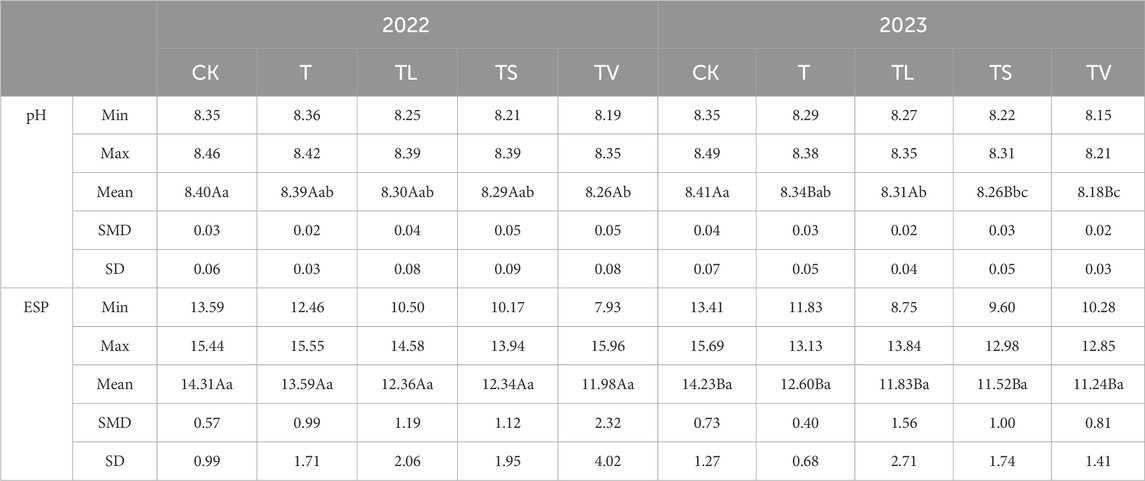
Table 1. Changes in soil pH and ESP under different treatments from 2022 to 2023. Based on the Duncan test, significant differences at P < 0.05 between various treatments within the same year are indicated by lowercase letters above the columns, while significant differences at P < 0.05 between the same treatments across different years are indicated by capital letters above the columns.
3.2 Soil organic carbon fraction
A significant increase in the soil organic carbon (SOC), easily oxidizable organic carbon (EOC), dissolved organic carbon (DOC), and microbial biomass carbon (MBC) contents of saline-alkali soil was observed in all of the treatments, except for CK (Figure 2). The SOC ranged from 5.89 to 8.98 g kg−1 in all of treatments. The SOC of CK was 6.16 g kg−1 and 6.11 g kg−1 in 2022 and 2023, respectively. In 2022, a significant increase of SOC in the T, TL, and TV treatments was observed compared with the CK treatment, with improvements of 4.21%, 18.11%, and 26.44%, respectively. The SOC in the TS treatment was highest, achieving a 29.09% increase over that in the CK treatment. In 2023, the T, TL, and TS treatments also significantly increased in terms of SOC content compared with the CK treatment, with increases of 7.08%, 19.29%, and 18.20%, respectively.
The EOC showed differences across treatments, ranged from 1.78 to 2.63 g kg−1. In 2022, the EOC content in the TV treatment increased the most significantly, with increments of 21.48%, 17.05%, 7.94%, and 6.25% compared with the CK, T, TL, and TS treatments. In 2023, the EOC content in the TV treatment continued to rise significantly when compared with the CK, T, TL, and TS treatments, with increases of 35.53%, 13.34%, 2.37%, and 2.90% respectively.
The TV treatment significantly increased soil DOC and MBC contents compared with the treatment without desulfurized gypsum (P < 0.05). The DOC in the T treatment increased by 7.8% and 5.97% compared to the CK treatment, whereas the TL treatment showed increases of 12.58% and 14.62% respectively. Similarly, the TS treatment exhibited increases of 12.58% and 14.62% respectively, and the TV treatment showed increases of 29.02% and 19.70% respectively.
The MBC in the T, TL, TS, and TV treatments increased by 5.81%, 16.12%, 25.70%, and 31.01% respectively, compared with the CK treatment. In 2023, the MBC in the T treatment decreased by 1.12% compared with the CK treatment, whereas the TL, TS, and TV treatments achieved a significantly higher MBC, increasing by 19.48%, 23.85%, and 34.93% respectively, compared with the CK treatment. These results reveal that the SOC, EOC, DOC, and MBC of TV treatment were the highest.
3.3 Soil nutrients
The TV treatment increased soil organic matter and TN content within a two-year period (Figures 3A, B). Each treatment showed a gradual increase in organic matter and total nitrogen (TN), with the TV treatment yielding the highest increase and the CK treatment yielding the lowest increase. The TV treatment showed a significant increase of 35.56% in organic matter and 17.46% in TN compared with the CK treatment in 2022. The TS treatment achieved a substantial increase of 29.67% in organic matter and 10.32% in TN, whereas the TL treatment showed an increase of 18.16% in organic matter and 1.19% in TN. The T treatment showed a slight increase in SOC and TN levels compared with the CK treatment, but the difference was not statistically significant. Similar trends have already observed in 2023.
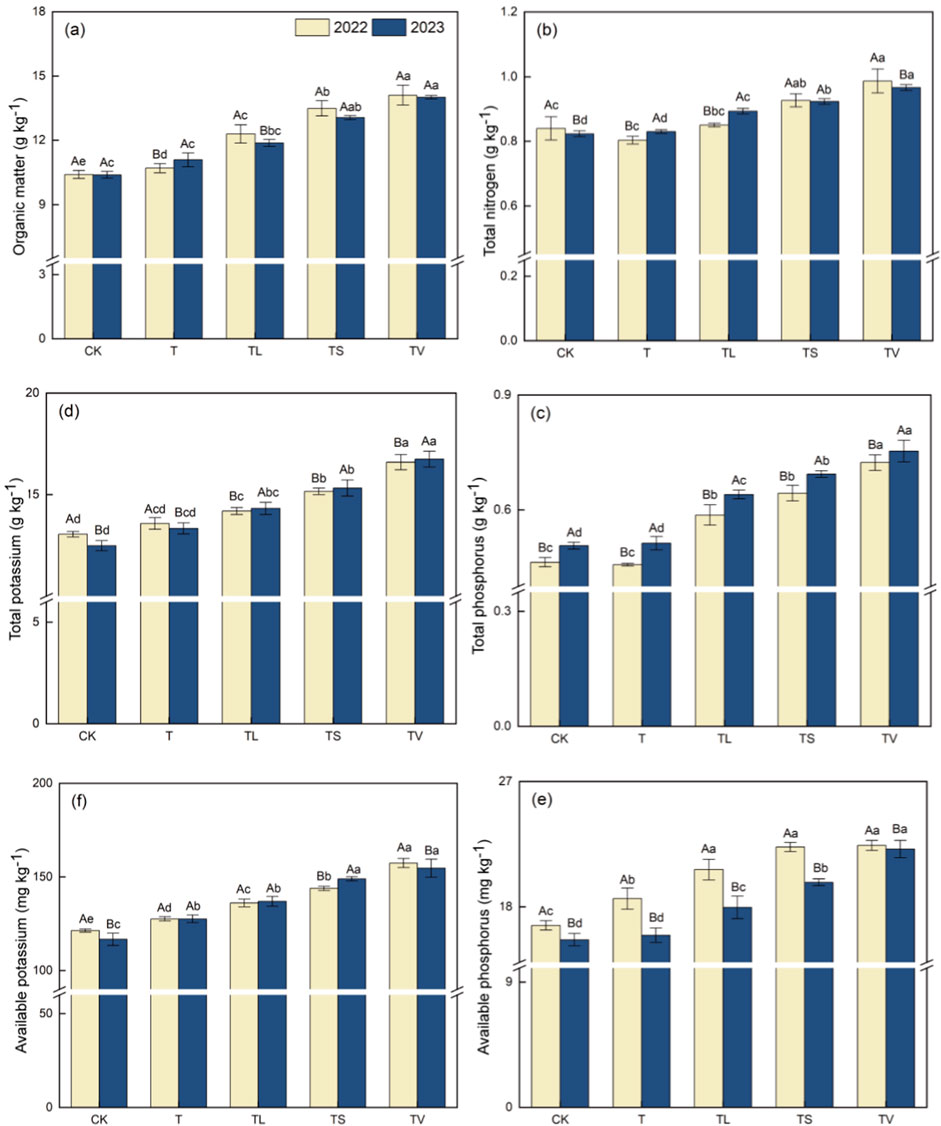
Figure 3. Soil properties under different treatments in 2022–2023. The standard deviation of the mean is shown by error bars. Based on the Duncan test, significant differences at P < 0.05 between various treatments within the same year are indicated by lowercase letters above the columns, while significant differences at P < 0.05 between the same treatments across different years are indicated by capital letters above the columns. The values presented are the averages of three samples, as are those below.
In 2022, with the exception of TP in the T treatment, the total potassium (TP), available phosphorus (AP), and available potassium (AK) levels in each treatment were significantly higher than in the CK treatment, with the differences observed being statistically significant (P < 0.05). In 2023, the TP, and AP in the T treatment, the total potassium (TK) and AK in each treatment were significantly elevated compared with the control group, with statistically significant differences between treatments (Figures 3C–F). The TV treatment showed the most significant enhancement among all of the treatments, with improvements following the following sequence: CK < T < TL < TS < TV. Compared to the CK, T, TS, and TL treatments, the TV treatment showed increase in TK content of 4.03%, 8.76%, 16.19%, and 27.20%, respectively. Additionally, the AP content increased by 11.58%, 24.08%, 33.81%, and 34.47%, respectively. The AK content also saw increases of 5.13%, 12.14%, 18.55%, and 29.67%, respectively. However, TP content decreased by 1.42% in the T treatment compared with the CK. In contrast, TP content increased by 26.63%, 38.85%, and 56.11% in the TL, TS, and TV treatments compared with the CK. Compared with the CK treatment, the contents of TP and TK were increased by 1.30%–48.66% and 6.86%–34.17%, respectively. The AP and AK contents increased by 2.00%–41.61% and 9.37%–32.53% compared with the CK treatment. The TV treatment can more effectively increase the contents of organic matter, TN, TP, TK, AP, and AK in the soil.
3.4 Changes in soil enzyme activities
Changes in soil enzyme activity under different treatment are shown in Figure 4. TV treatment was significantly higher in soil phosphatase activity (SPA), soil urease activity (SUA) and soil sucrase activity (SSA), followed closely by TS, TL, T and CK treatments. The SPA activity in the TV treatment was significantly higher than that in the other treatment conditions, which increased by 39.90%, 32.37%, 11.65% and 11.70%, respectively, compared with CK, T, TL and TS treatments. In terms of SUA activity, significant differences were observed between treatments, with the TV treatment showing the highest level and CK treatment showing the lowest level. The TV treatment also showed obvious advantages, with an increase ranging from 6.45% to 34.59%. The differences in soil SPA and SSA activities between TV and TS treatments were not significant in 2023, but they were still significantly higher than other treatment conditions. At the same time, the differences between T and CK treatments were also not significant. Different treatments and treatment conditions had significant effects on soil enzyme activity. TV treatment showed higher SPA and SSA activities levels, whereas SUA activity ranked from highest to lowest was TV > TS > TL > T > CK (P < 0.05). In summary, the TV treatment could more effectively increase the activities of soil phosphatase activity (SPA), soil urease activity (SUA) and soil sucrase activity (SSA) in the soil.
3.5 Maize yield
Maize yield ranged from 7,048 kg ha−1 to 8,037.66 kg ha−1 in all of the treatment, with the TV treatment showing the largest increase, at 14.04% higher than CK. Similarly, the maize yield for each treatment increased from 6,808.33 kg ha−1 to 7,991.66 kg ha−1in 2023, with the TV treatment being the highest, increasing by 17.38% compared to the CK treatment (Figure 5). The ranking order of maize yield across treatments was TV > TS > TL > T > CK.
3.6 Correlation among variables and principal component analysis
The correlation of TN, TP, TK, AP, AK, SPA, SUA, SSA, SOC, DOC, EOC, and MBC and yield are shown in Figures 6A, B. Maize yield was significantly positively correlated with other indicators (r ≥ 0.77 and r ≥ 0.82). In 2022, the first principal component (PC1) accounted for 88.5% of the variation, whereas PC2 explained 4.0% of it. In 2023, PC1 explained 91.2% of the variation, and PC2 explained 3.2% (Figure 7). A significant positive correlation existed between soil organic matter, TN, TP, TK, AP, AK, SOC, EOC, DOC, MBC, SPA, SUA, SSA and maize yield.
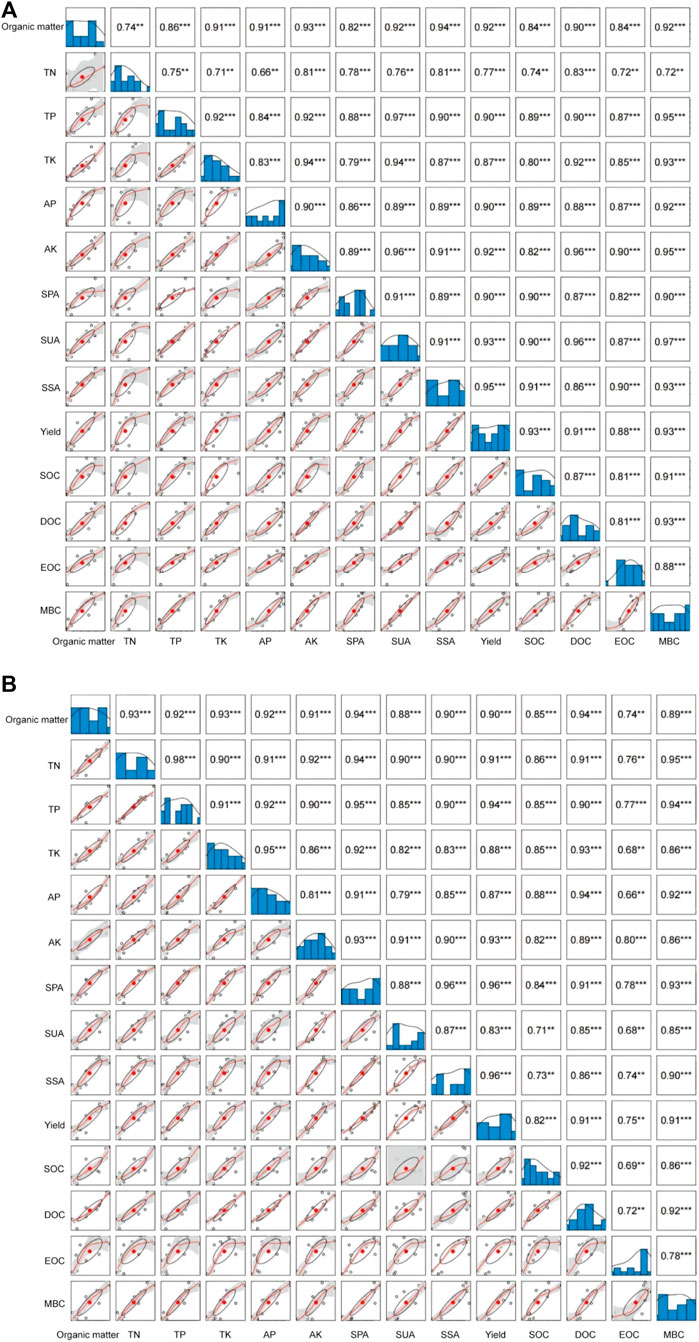
Figure 6. Correlation between soil organic matter, total nitrogen (TN), total phosphorus (TP), total potassium (TK), available phosphorus (AP), available potassium (AK), soil organic carbon (SOC), easily oxidizable organic carbon (EOC), dissolved organic carbon (DOC), microbial biomass carbon (MBC), soi phosphatase activity (SPA), soil urease activity (SUA), soil sucrase activity (SSA) and maize yield in 2022 and 2023.
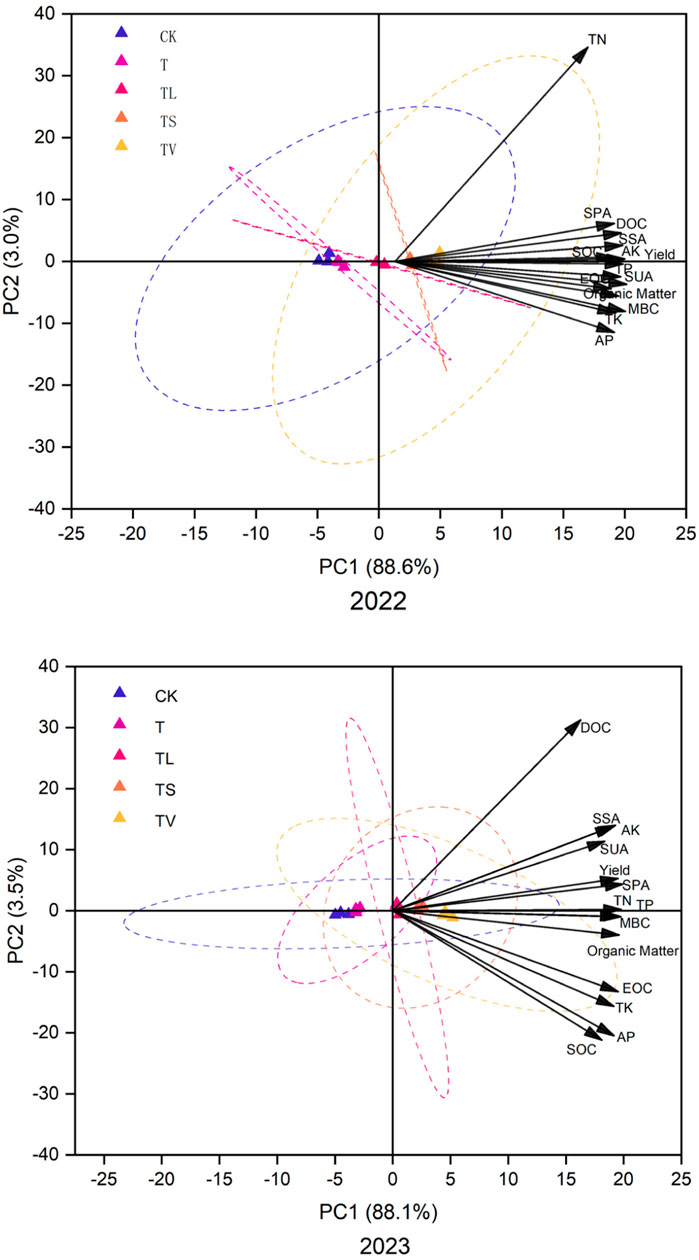
Figure 7. Principal component analysis of soil organic matter, total nitrogen (TN), total phosphorus (TP), total potassium (TK), available phosphorus (AP), available potassium (AK), soil organic carbon (SOC), easily oxidizable organic carbon (EOC), dissolved organic carbon (DOC), microbial biomass carbon (MBC), soi phosphatase activity (SPA), soil urease activity (SUA), soil sucrase activity (SSA) and maize yield.
3.7 Determination of optimal management model based on gray correlation analysis, membership function and entropy weighted TOPSIS model
Soil chemical indicators were measured after applying combined additives, and the improvement effect was comprehensively evaluated and analyzed using an evaluation function to determine the optimal combination. The results show that the combined additives effectively improved saline-alkali soil in northern Shaanxi, thereby also improving land-resource utilization. Based on the collected data on soil organic matter,TN, TP, TK, AP, AK, phosphatase, urease, sucrase, and yield, the soil comprehensive index was evaluated using the membership function method, weighted TOPSIS method, and gray correlation analysis method (Figure 8). The results show correlations among the different evaluation methods. Specifically, TV and TS were ranked first and second in both 2022 and 2023.
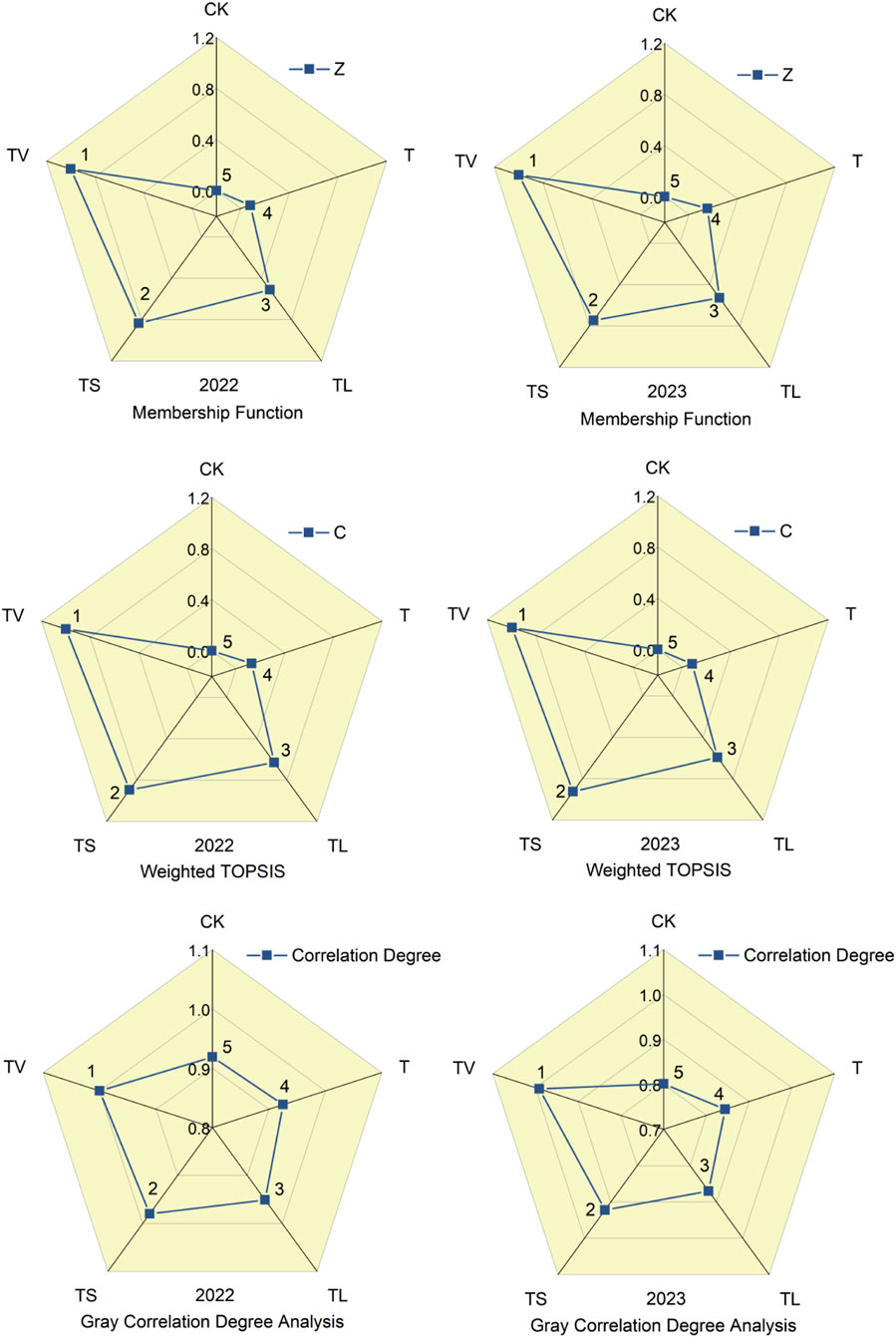
Figure 8. The rank of each treatment in two consecutive experiment years (2022–2023). Arabic numerals represent sorting between processes.
4 Discussion
4.1 Effects of gypsum improvers and organic materials on organic carbon franction in saline-alkali soil
Organic carbon plays a crucial role in the soil cycle, impacting the physical and chemical properties of the soil, as well as its biological processes (Ma et al., 2016). It is commonly used as a metric to assess soil quality. In the study, the T, TL, and TV treatments significantly increased SOC content compared with the CK treatment, which suggest that the TS and TV treatments are more effective in increasing SOC in saline-alkali soils than the T and TL treatments are. The results of this study align with prior results obtained by Romero-Cortes et al., indicating that the use of organic fertilizers supplies organic matter to the soil and improves soil nutrients, enzyme activity, and microbial diversity, thus increasing SOC content levels (Romero-Cortes et al., 2022). In this study, the treatment of the combined application of desulfurized gypsum and straw (TS) could effectively increase the content of organic matter in the soil. The utilization of straw materials directly enhances the organic matter content in the soil and introduces a new carbon source (Zhang et al., 2022). As this organic matter breaks down in the soil, it transforms into stable organic carbon, consequently increasing the SOC content. The application of desulfurized gypsum enhances the physical and chemical properties of the soil, offering the unique advantage of long-term CO2 stabilization and facilitating the development of soil inorganic carbon (Wang et al., 2017). Moreover, in calcareous soil, desulfurized gypsum facilitates the bonding of minerals and organic matter, forming an organic-mineral combination that boosts the resilience of the organic matter against decomposition. This process allows for a more efficient conversion of carbon from straw materials into stable organic carbon within the soil.
Soil active organic carbon is highly responsive to soil-management practices and serves as a valuable soil-quality and nutrient-cycling indicator (Oechaiyaphum et al., 2020). The results of this study show that all of amendment treatments increased soil EOC, DOC and MBC levels compared with the control treatment. Previous research has shown that this result can be attributed to the enhancement of crop-root and soil-microorganism activities, resulting in higher secretion of metabolites and subsequent rise in soil active organic carbon content (Iqbal et al., 2022). In particular, the TV treatment showed the most significant enhancement of all of the treatments. The application of organic fertilizers supplied ample carbon sources and energy materials for microorganisms, stimulating their growth and reproduction, thereby boosting microbial activity and leading to a greater release of active organic carbon, consequently elevating the soil EOC, DOC, and MBC.
In our study, the application of desulfurization gypsum alone, the combination of desulfurization gypsum and green manure, and the combination of desulfurization gypsum and straw all had a certain effect on the proportion of soil EOC, DOC, and MBC. However, the effect was not as significant as the combination of desulfurization gypsum and organic fertilizer. This result aligns with previous research results, suggesting that organic fertilizers enhance soil physical and chemical properties, promote the formation of soil micro-aggregate structure, and increase the abundance and diversity of soil microorganisms, thus elevating the relative proportion of soil active organic carbon components (Liu et al., 2022). The correlation analysis revealed a significant positive correlation between soil SOC and EOC, DOC, and MBC, indicating that soil active organic carbon contents is largely influenced by SOC content.
4.2 Effects of gypsum amendment and organic matter on soil nutrients in saline-alkali soil
Soil nutrients play a crucial role in soil fertility and are integral to the overall structure of farmland soil (Wang et al., 2015). In our study, both the desulfurization gypsum and organic material treatments (TL and TS) significantly increased post-harvest organic matter and TN contents in both years compared with the CK treatment (Figure 3), whcih can be attributed to the synergistic effect of desulfurized gypsum and organic material, which stimulated crop canopy growth, increased root biomass and stubble, and reduced nitrate nitrogen leaching. Application of desulfurized gypsum and organic fertilizer (TV) treatment can more effectively increase soil nutrients. The organic fertilizer used in our study also notably boosted soil organic matter content, facilitated soil carbon sequestration and aggregation, and minimized soil carbon loss, potentially explaining the observed increase in soil organic matter. For the same treatment, Xie et al. studied the gradient application of organic fertilizer and found that soil available nitrogen, organic carbon, and TN increased significantly within 3 years in southwest China, especially under the 100% organic fertilizer treatment (Xie et al., 2022). These results are consistent with our research results. Conversely, our study found no significant differences in soil organic matter and TN between T and CK treatments (Figure 3). Several studies have shown that the long-term impact of organic fertilizers on soil enhancement varies based on factors such as the type of organic fertilizer, soil texture, hydrothermal conditions, precipitation, and crop species (Xin et al., 2016). In a two-year field experiment conducted by Cheng et al., it was observed that replacing organic fertilizers could significantly enhance soil structural properties, reduce soil salinity, and increase crop yield and water and fertilizer efficiency (Cheng et al., 2023). Over the course of our two-year investigation, organic fertilizer was found to significantly modify soil hydrology and thermal properties, enhance soil structure, and consequently facilitate crop growth and grain yield, particularly with the TV treatment.
Moreover, by adding desulfurized gypsum, which is beneficial to increase the number of aggregates in the soil, small particles ca be transformed into large particles, increasing soil pores, and, reducing the salt-alkali stress. Desulfurization gypsum is rich in sulfur, calcium, silicon, and other elements. The calcium element has a beneficial effect on soil nutrient and stress resistance.
The soil salinity and alkalinity of soda saline-alkali soil leads to nutrient deficiency, which greatly reduces plant growth. Its salinity is mainly caused by NaHCO3 and Na2CO3 as well as a small amount of sulfate and chloride. Soil organic matter, TN, TP, TK, and available nutrients are crucial indicators for assessing cultivated land quality (Gao et al., 2021). This study revealed that combining desulfurization gypsum with different organic materials could partially address these concerns. Among the combinations tested, the TV treatment showed the most significant improvement in fertility indicators across different soil layers. This was attributed to the organic fertilizer in the TV treatment enriching the nutrient-poor soil with organic matter and trace elements. In addition, the use of microbial fertilizer enhanced soil microorganism populations and related enzyme activities, increasing available nutrients and organic matter contents in saline-alkali soil, aligning with the results of other amendments and organic materials tests. This study results indicate that the optimal application amount for improving nutrients in saline-alkali soil is 2.5 t ha−1 of desulfurized gypsum and 1.5 t ha−1 of organic fertilizer, representing the TV treatment.
4.3 Effects of gypsum amendment and organic matter on soil enzyme activities in saline-alkali soil
Soil enzymes play a crucial role in the biogeochemical cycling of nutrients (Li et al., 2017). The activities of these enzymes are influenced by the number and abundance of microbes, which are valuable indicator of microbial nutrient requirements. Microbial are typically hindered by salt stress in saline-alkali soils, resulting in lower enzyme activity compared to non-saline-alkali soils (Li et al., 2020). However, the addition of desulfurized gypsum and organic materials can stimulate the activities of SPA, SUA, and SSA enzymes, with the specific effects varying depending on the type of organic material added. The study showed that the treatments (TV) with desulfurized gypsum and organic fertilizers significantly increased the activities of SPA, SUA, and SSA. Compared with CK, the activities of SPA, SUA, and SSA in were improved by 39.9%, 38.9%, and 34.59% respectively. Furthermore, the activities of SPA, SUA and SSA with the TV treatment increased significantly by 50.66%, 26.38% and 38.19% respectively, compared with the CK treatment in 2023. This increase in enzyme activity is likely to the enhanced availability of nutrients such as nitrogen, phosphorus, and potassium, which in turn, promote microbial biomass and diversity (Dang et al., 2022). These results align with those of previous research, indicating organic material inputs can significantly boost enzyme activity in saline-alkali soils (Gao et al., 2022). The impact of desulfurized gypsum and organic materials on soil enzyme activity is influenced by microbial mass and enzyme activity per unit biomass. In summary, the treatment (T) with a single application of desulfurized gypsum had the lowest efficiency among all of treatments in improving the activities of SPA, SUA, and SSA in the soil.
4.4 Effects of gypsum amendment and organic matter on maize yield in saline-alkali soil
The utilization of desulfurized gypsum and organic materials has been found to enhance soil organic matter, TN, TP, TK, AP, and AK levels, potentially fostering the growth of corn. Organic materials can boost plant development and crop yields by acting as a direct nutrient source or by modifying nutrient availability through processes (Zhang et al., 2020). Numerous studies have shown that organic materials can effectively supply plants with significant quantities of accessible nutrients (Wang et al., 2023). Organic materials both reduc water permeability and facilitates the absorption of filtered nutrients. The results in a gradual release of nutrients in the soil, thereby enhancing crop-nutrient levels (Xiao et al., 2022). Moreover, the porosity of organic materials enhances soil aeration, supports the growth of plant roots, and aids in the uptake of nutrients and water by corn, consequently increasing maize yields. Our study clearly showed that the addition of external organic materials increased yields in the following order: TV > TS > TL > T > CK. Across all of treatments, both desulfurized gypsum and organic fertilizer treatment had an average yield increase of 14.04% in 2022, whereas the grain yields in desulfurized gypsum treatment were 12.03% lower than those in treatment with both desulfurized gypsum and organic fertilizer. In 2023, with plots treated only with fertilizer showed an average yield increase of 17.38%, with plots treated only with desulfurized gypsum having yields 15.77% lower than those treated with both desulfurized gypsum and organic fertilizer. In summary, desulfurized gypsum and organic fertilizer treatment (TV) could increase maize yield in saline-alkali soil.
5 Conclusion
This study investigated the impact of desulfurized gypsum, green manure, straw, and organic fertilizer as soil amendments on enhancing saline-alkali soil quality. Long-term experimental data from 2022 to 2023 revealed that the application of desulfurized gypsum alone or in combination with organic matter effectively lowered soil pH and exchange sodium percentage, whereas increasing organic matter, TN, TP, and TK contents in saline-alkali soil. In addition, it boosted AP and AK levels, enhanced SPA, SUA and SSA, and ultimately increased the maize yield. The combined use of desulfurized gypsum and organic fertilizer was found to be the most effective strategy. By employing desulfurized gypsum and organic fertilizers, soil salinity issues can be addressed while simultaneously significantly increasing soil nutrients, improving soil quality, and enhancing maize yields. These research results contribute to the advancement of saline-alkali soil enhancement theory and also offer valuable insights for practical soil management and sustainable agricultural development. Thus, it is recommended that farmers in the northern Loess Plateau utilize desulfurized gypsum and organic materials to optimize soil resources and boost maize yield.
Data availability statement
The original contributions presented in the study are included in the article/supplementary material, further inquiries can be directed to the corresponding author.
Author contributions
YT: Writing–original draft, Writing–review and editing. WJ: Writing–review and editing. GC: Writing–review and editing. XW: Writing–review and editing. TL: Writing–review and editing.
Funding
The author(s) declare that financial support was received for the research, authorship, and/or publication of this article. This research was supported by the “Shaanxi Provincial Science and Technology Department basic plan project, Grant No.2023-JC-QN-0371”; “Yan’an Science and Technology Plan Project, Grant No. 2023-SFGG-113” and “Innovation and Entrepreneurship Training Program for College Students in Yan’an University, Grant No. D2023103.”
Conflict of interest
The authors declare that the research was conducted in the absence of any commercial or financial relationships that could be construed as a potential conflict of interest.
Publisher’s note
All claims expressed in this article are solely those of the authors and do not necessarily represent those of their affiliated organizations, or those of the publisher, the editors and the reviewers. Any product that may be evaluated in this article, or claim that may be made by its manufacturer, is not guaranteed or endorsed by the publisher.
References
Ai, F., He, L., Li, Q., Li, B., Zhang, K., Yang, H., et al. (2023). Vermicompost combined with soil conditioner improves the ecosystem multifunctionality in saline-alkali land. Water 15 (17), 3075. Artikkel 3075. doi:10.3390/w15173075
Bao, S., Wang, Q., Bao, X., Li, M., and Wang, Z. (2016). Biological treatment of saline-alkali soil by Sulfur-oxidizing bacteria. Bioengineered 7 (5), 372–375. doi:10.1080/21655979.2016.1226664
Boamah, S., Zhang, S., Xu, B., Li, T., and Calderon-Urrea, A. (2021). Trichoderma longibrachiatum (TG1) enhances wheat seedlings tolerance to salt stress and resistance to fusarium pseudograminearum. Front. Plant Sci. 12, 741231. doi:10.3389/fpls.2021.741231
Cheng, Y., Luo, M., Zhang, T., Yan, S., Wang, C., Feng, H., et al. (2023). Organic substitution improves soil structure and water and nitrogen status to promote sunflower (Helianthus annuus L.) growth in an arid saline area. Agric. Water Manag. 283, 108320. doi:10.1016/j.agwat.2023.108320
Dang, H., Zhao, W., Zhang, T., Cheng, Y., Dong, J., and Zhuang, L. (2022). Great gerbil burrowing-induced microbial diversity shapes the rhizosphere soil microenvironments of Haloxylon ammodendron in temperate deserts. Front. Microbiol. 13, 960594. doi:10.3389/fmicb.2022.960594
Dick, R. P., Breakwell, D. P., and Turco, R. F. (1997). Soil enzyme activities and biodiversity measurements as integrative microbiological indicators. Methods Assess. soil Qual. 49, 247–271. doi:10.2136/sssaspecpub49.c15
Gao, L., Huang, M., Zhang, W., Qiao, L., Wang, G., and Zhang, X. (2021). Comparative study on spatial digital mapping methods of soil nutrients based on different geospatial technologies. Sustainability 13 (6), 3270. doi:10.3390/su13063270
Gao, Y., Jin, Y., Guo, W., Xue, Y., and Yu, L. (2022). Metabolic and physiological changes in the roots of two oat cultivars in response to complex saline-alkali stress. Front. Plant Sci. 13, 835414. doi:10.3389/fpls.2022.835414
Iqbal, A., He, L., Ali, I., Yuan, P., Khan, A., Hua, Z., et al. (2022). Partial substation of organic fertilizer with chemical fertilizer improves soil biochemical attributes, rice yields, and restores bacterial community diversity in a paddy field. Front. plant Sci. 13, 895230. doi:10.3389/fpls.2022.895230
Jia, X. M., Zhu, Y. F., Hu, Y., Zhang, R., Cheng, L., Zhu, Z. L., et al. (2019). Integrated physiologic, proteomic, and metabolomic analyses of Malus halliana adaptation to saline-alkali stress. Hortic. Res. 6, 91. doi:10.1038/s41438-019-0172-0
Jiang, W. T., Gong, L., Yang, L. H., He, S. Q., and Liu, X. H. (2021). Dynamics in C, N, and P stoichiometry and microbial biomass following soil depth and vegetation types in low mountain and hill region of China. Sci. Rep. 11 (1). doi:10.1038/s41598-021-99075-5
Kohout, P., Sudova, R., Brabcova, V., Vosolsobe, S., Baldrian, P., and Albrechtova, J. (2021). Forest microhabitat affects succession of fungal communities on decomposing fine tree roots. Front. Microbiol. 12, 541583. doi:10.3389/fmicb.2021.541583
Kovacova, V., and Veliskova, Y. (2012). The risk of the soil salinization of the eastern part of zitny ostrov. J. Hydrology Hydromechanics 60 (1), 57–63. doi:10.2478/v10098-012-0005-4
Li, F., Chen, L., Zhang, J., Yin, J., and Huang, S. (2017). Bacterial community structure after long-term organic and inorganic fertilization reveals important associations between soil nutrients and specific taxa involved in nutrient transformations. Front. Microbiol. 8, 187. doi:10.3389/fmicb.2017.00187
Li, S., Yang, Y., Li, Y., Gao, B., Tang, Y., Xie, J., et al. (2020). Remediation of saline-sodic soil using organic and inorganic amendments: physical, chemical, and enzyme activity properties. J. Soils Sediments 20 (3), 1454–1467. doi:10.1007/s11368-019-02510-4
Liu, M., Linna, C., Ma, S., Ma, Q., Guo, J., Wang, F., et al. (2022). Effects of biochar with Inorganic and organic fertilizers on agronomic traits and nutrient absorption of soybean and fertility and microbes in purple soil. Front. Plant Sci. 13, 871021. doi:10.3389/fpls.2022.871021
Lu, X., Lu, X., and Liao, Y. (2018). Effect of tillage treatment on the diversity of soil arbuscular mycorrhizal fungal and soil aggregate-associated carbon content. Front. Microbiol. 9, 2986. doi:10.3389/fmicb.2018.02986
Ma, D., Chen, L., Qu, H., Wang, Y., Misselbrook, T., and Jiang, R. (2018). Impacts of plastic film mulching on crop yields, soil water, nitrate, and organic carbon in Northwestern China: a meta-analysis. Agric. Water Manag. 202, 166–173. doi:10.1016/j.agwat.2018.02.001
Ma, Z., Chen, J., Lyu, X., Liu, L.-l., and Siddique, K. H. M. (2016). Distribution of soil carbon and grain yield of spring wheat under a permanent raised bed planting system in an arid area of northwest China. Soil & Tillage Res. 163, 274–281. doi:10.1016/j.still.2016.05.010
Misra, P., Maji, D., Awasthi, A., Pandey, S. S., Yadav, A., Pandey, A., et al. (2019). Vulnerability of soil microbiome to monocropping of medicinal and aromatic plants and its restoration through intercropping and organic amendments. Front. Microbiol. 10, 2604. doi:10.3389/fmicb.2019.02604
Oechaiyaphum, K., Ullah, H., Shrestha, R. P., and Datta, A. (2020). Impact of long-term agricultural management practices on soil organic carbon and soil fertility of paddy fields in Northeastern Thailand. Geoderma Reg. 22, e00307. doi:10.1016/j.geodrs.2020.e00307
Osman, K. S., Jashimuddin, M., Haque, S. M. S., and Miah, S. (2013). Effect of shifting cultivation on soil physical and chemical properties in Bandarban hill district, Bangladesh. J. For. Res. 24 (4), 791–795. doi:10.1007/s11676-013-0368-3
Petersen, E. H., and Hoyle, F. C. (2016). Estimating the economic value of soil organic carbon for grains cropping systems in Western Australia. Soil Res. 54 (4), 383–396. doi:10.1071/sr15101
Qi, P., Zhao, C., and Feng, Z. (2010). GIS- and machine learning-based modeling of the potential distribution of broadleaved deciduous forest in the Chinese loess plateau. Giscience & Remote Sens. 47 (1), 99–114. doi:10.2747/1548-1603.47.1.99
Romero-Cortes, T., Tamayo-Rivera, L., Morales-Ovando, M. A., Aparicio Burgos, J. E., Perez Espana, V. H., Peralta-Gil, M., et al. (2022). Growth and yield of purple kculli corn plants under different fertilization schemes. J. Fungi 8 (5), 433. doi:10.3390/jof8050433
Sun, X., Ye, Y., Ma, Q., Guan, Q., and Jones, D. L. (2021). Variation in enzyme activities involved in carbon and nitrogen cycling in rhizosphere and bulk soil after organic mulching. Rhizosphere 19, 100376. doi:10.1016/j.rhisph.2021.100376
Toubali, S., Ait-El-Mokhtar, M., Boutasknit, A., Anli, M., Ait-Rahou, Y., Benaffari, W., et al. (2022). Root reinforcement improved performance, productivity, and grain bioactive quality of field-droughted quinoa (Chenopodium quinoa). Front. Plant Sci. 13, 860484. doi:10.3389/fpls.2022.860484
Wang, H., Qu, Y., Wen, Z., Cheng, M., Zhang, F., Fan, J., et al. (2024). Interactive effects of irrigation and N fertilization management on fruit yield, quality and water-N productivity of greenhouse cherry tomato. Sci. Hortic. 328, 112895. doi:10.1016/j.scienta.2024.112895
Wang, S. J., Chen, Q., Li, Y., Zhuo, Y. Q., and Xu, L. Z. (2017). Research on saline-alkali soil amelioration with FGD gypsum. Resour. Conservation Recycl. 121, 82–92. doi:10.1016/j.resconrec.2016.04.005
Wang, Y., Gao, M., Chen, H., Chen, Y., Wang, L., and Wang, R. (2023). Organic Amendments promote saline-alkali soil desalinization and enhance maize growth. Front. Plant Sci. 14, 1177209. doi:10.3389/fpls.2023.1177209
Wang, Z.-G., Hu, Y.-L., Xu, W.-H., Liu, S., Hu, Y., and Zhang, Y. (2015). Impacts of dimethyl phthalate on the bacterial community and functions in black soils. Front. Microbiol. 6, 405. doi:10.3389/fmicb.2015.00405
Xiao, X., Li, J., Lyu, J., Feng, Z., Zhang, G., Yang, H., et al. (2022). Chemical fertilizer reduction combined with bio-organic fertilizers increases cauliflower yield via regulation of soil biochemical properties and bacterial communities in Northwest China. Front. Microbiol. 13, 922149. doi:10.3389/fmicb.2022.922149
Xie, J., Shi, X., Zhang, Y., Wan, Y., Hu, Q., Zhang, Y., et al. (2022). Improved nitrogen use efficiency, carbon sequestration and reduced environmental contamination under a gradient of manure application. Soil & Tillage Res. 220, 105386. doi:10.1016/j.still.2022.105386
Xin, X., Zhang, J., Zhu, A., and Zhang, C. (2016). Effects of long-term (23 years) mineral fertilizer and compost application on physical properties of fluvo-aquic soil in the North China Plain. Soil & Tillage Res. 156, 166–172. doi:10.1016/j.still.2015.10.012
Zhang, C., Liu, H., Liu, S., Hussain, S., Zhang, L., Yu, X., et al. (2022). Response of fungal sub-communities in a maize-wheat rotation field subjected to long-term conservation tillage management. Front. Microbiol. 13, 829152. doi:10.3389/fmicb.2022.829152
Zhang, Y., Hao, X., Garcia-Lemos, A. M., Nunes, I., Nicolaisen, M. H., and Nybroe, O. (2020). Different effects of soil fertilization on bacterial community composition in the penicillium canescens hyphosphere and in bulk soil. Appl. Environ. Microbiol. 86 (10), e02969. doi:10.1128/aem.02969-19
Zhao, Y., Wang, S., Li, Y., Liu, J., Zhuo, Y., Chen, H., et al. (2018). Extensive reclamation of saline-sodic soils with flue gas desulfurization gypsum on the Songnen Plain, Northeast China. Geoderma 321, 52–60. doi:10.1016/j.geoderma.2018.01.033
Zhou, J., Qi, A., Wang, B., Zhang, X., Dong, Q., and Liu, J. (2022). Integrated analyses of transcriptome and chlorophyll fluorescence characteristics reveal the mechanism underlying saline-alkali stress tolerance in kosteletzkya pentacarpos. Front. Plant Sci. 13, 865572. doi:10.3389/fpls.2022.865572
Keywords: saline-alkali soil, soil amendment, crop straw, desulfurized gypsum, soil properties
Citation: Tian Y, Jiang W, Chen G, Wang X and Li T (2024) Gypsum and organic materials improved soil quality and crop production in saline-alkali on the loess plateau of China. Front. Environ. Sci. 12:1434147. doi: 10.3389/fenvs.2024.1434147
Received: 17 May 2024; Accepted: 09 August 2024;
Published: 26 August 2024.
Edited by:
Caiqing Qin, Xi’an Jiaotong University, ChinaReviewed by:
Xiaodong Zhang, Tianjin University, ChinaHuili Zhao, Ludong University, China
Jianye Ma, Xian University of technoloy, China
Copyright © 2024 Tian, Jiang, Chen, Wang and Li. This is an open-access article distributed under the terms of the Creative Commons Attribution License (CC BY). The use, distribution or reproduction in other forums is permitted, provided the original author(s) and the copyright owner(s) are credited and that the original publication in this journal is cited, in accordance with accepted academic practice. No use, distribution or reproduction is permitted which does not comply with these terms.
*Correspondence: Wenting Jiang, amlhbmd3ZW50aW5nQHlhdS5lZHUuY24=
 Ye Tian
Ye Tian Wenting Jiang
Wenting Jiang Guoliang Chen1,2,3
Guoliang Chen1,2,3 Xiukang Wang
Xiukang Wang